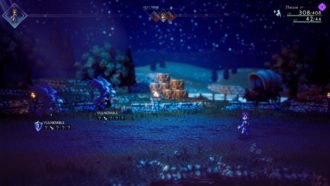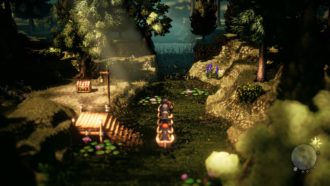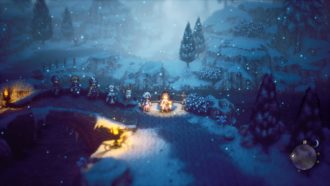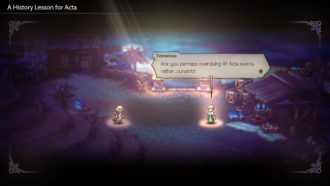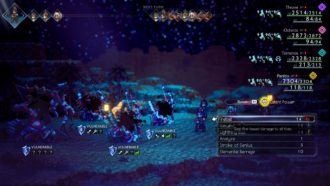Platforms:
PS4, PC, Nintendo Switch, PS5
Released:
February 24, 2023
Publisher:
Square Enix
Developer:
Square Enix
Five years has passed since the release of Square Enix’s Octopath Traveler, and its sequel, the aptly-named Octopath Traveler II, has now launched as a multi-platform release. Taking the “if it ain’t broke, don’t fix it” approach to sequel design, Octopath Traveler II is a more robust revisit of the first game’s formula, improving in many areas, yet migrating many of the first game’s flaws. With a compelling and well-written new batch of heroes, some welcome gameplay tweaks and a giant world to explore, Octopath Traveler II is a fantastic JRPG that genre fans will love, as long as they have a tolerance for grinding and aren’t looking for too much innovation.
Just like the first game, Octopath Traveler II starts out inviting you to pick one of eight protagonists whose story you would like to follow first. After completing the first chapter of their story, you then are free to explore the world and steadily recruit the remaining seven heroes to add to your roster. Each of the characters fills the same gameplay niches as the first game; you still have a thief, a merchant, a cleric etc. However each character’s personality and arc is generally distinct enough from their Octopath Traveler I counterpart that the sequel overall doesn’t feel like it’s retreading old ground too much. The characters themselves are very charming, from the eccentric Sherlock Holmes-esque cleric Temenos solving a murder mystery, to the laidback and friendly merchant Partitio travelling around trying to make the world a better place.
“…each story basically plays out inside weird narrative bubbles where the character plotlines don’t impact one another…”
No matter who you start with and have in your party, Octopath Traveler II’s chapters still have the same issue as the first game, where each story basically plays out inside weird narrative bubbles where the character plotlines don’t impact one another, and the characters barely interact. Each cutscene during a character’s chapter plays as if they are travelling solo, and all interactions between party members are confined to Party Banter mini-cutscenes, and new “Crossed Paths” mini-chapters.
You’re encouraged to play through several characters’ plotlines concurrently, rather than one at a time, leading to strange tone shifts as you play a chapter of Osvald’s dark and serious prison break plotline and exploring his tragic backstory, and then a chapter of Ochette’s quirky “gotta-catch-’em-all” monster collection quest. As you are jumping between storylines, it can be many real-world hours between each character’s chapters, leading storylines to feel disjointed as you forget what happened in the last one and need to return to your in-game journal to remind yourself. The tone issue can be mitigated if you play through the storylines in a particular order, or force yourself to do one whole story at a time. However, this issue highlights the drawbacks and inefficiencies of telling each character’s storyline separately, rather than treating the party as an actual ensemble cast and spotlighting certain characters at different times when appropriate, like most other JRPGs do.
I enjoyed the interactions that we got and seeing how, say, the grim, determined assassin Throné and jovial merchant Partitio bounce off one another. The continued lack of integration between the storylines for the most part still feels like an odd missed opportunity.
As far as the gameplay goes, it maintains the formula of the first game, with some expansions and alterations in some places. Combat is still turn-based, and focused around “breaking” your opponents by attacking them with weapon and elemental attacks that they are weak to. Characters can attack multiple times or power up their special abilities by spending BP, a resource that recharges every turn. While each character has a native Job, providing skills and weapon proficiencies, characters can equip sub-Jobs later in the game to expand their capabilities. Character-specific Latent Abilities have been added, which charge up during combat and provide crucial buffs, like giving characters an extra turn or refilling their BP.
Outside of combat, each character has Path Actions to interact with the world around them. New to Octopath Traveler II is the introduction of a day and night cycle, and players can switch from night to day with the push of a button. Each character has both a day and night Path Action, doubling the number of Path Actions compared to the first game. These range from Partitio the Merchant being able to purchase items and weapons from NPCs, to Ochette the Hunter being able to bribe NPCs to help her in combat with jerky she acquires from monsters.

Fundamentally, the combat works as well as the first game’s does, with the addition of more dynamic camera moves and visual effects to add some real oomph to certain special attacks. Unfortunately, the overall lack of changes to the combat means that it has most of the same flaws as the first game, meaning that it can be grind-tastic at many points. As with the original, you cannot remove whichever character you started with from your main party, despite them not having any more plot relevance than anyone else. Each character chapter has a recommended level, which often have substantial jumps from one to the next.
What’s more. despite having eight characters overall, all of whom you must adequately level up by the endgame, you can only have four characters in your active party at once. There is no leaked experience to help your backup team to catch up. You can basically choose between picking four characters to start with and doing all of their chapters in one go, and then doing the other four later, or picking your starter character and then having a revolving door of three other party members to level up together, all while juggling sub-Jobs and equipment between them as you swap them around. Neither is particularly great, and just letting your backup party gain experience as well, or letting you swap them in during combat like in Persona 5, would have done wonders for the game’s pacing.
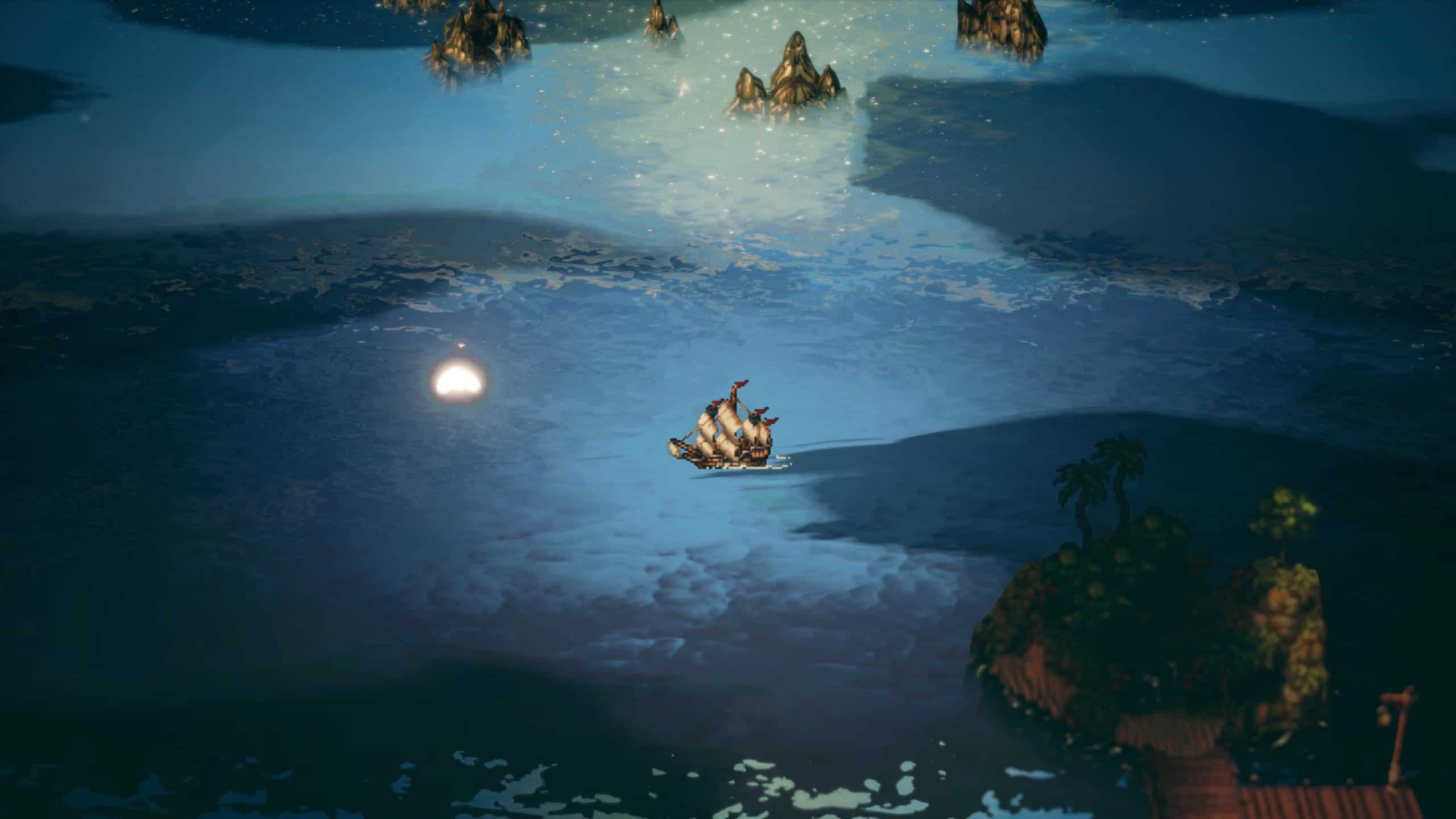
Despite my issues with the in-game progression, I can’t fault Octopath Traveler II on how gorgeous and expansive its world is. Appropriate for a game with Traveler in its name, you need to get most places on foot or by boat (at least at first; there is a handy fast-travel feature to return to anywhere you have previously visited).
The landscapes are a joy to behold, from the shifting sands of the deserts in Hinoema to the vibrant forests of the Leaflands. The environment you explore is amazing to look at, and provided a good motivation to see what was waiting beyond the next loading screen. While the HD-2D art style might not be as impactful now that games like Triangle Strategy have also utilised it, it still looks suitably stunning here.
It also helps that Octopath Traveler II sounds great as well. Many of the game’s audio cues during combat, such as the appropriately energetic voice lines to the pleasing glass-smashing sound which plays when you successfully break an enemy’s defences, gives extra weight to your more powerful attacks and makese them feel impactful. The orchestrated soundtrack is also as great to listen to as the first one, with neat additional touches such as most background musical themes having slower-paced and quieter remixes which play at night-time.
8
Great
Positive:
- Charming and varied cast of characters
- Tactical and engaging combat system
- A gorgeous and vibrant world to explore
- Fantastic soundtrack and sound design
Negative:
- Lack of interaction between characters still feels like a missed opportunity
- Pacing issues due to time gaps between character development
- Amount of level grinding between chapters may turn many players off
If you loved Octopath Traveler or are just a fan of expansive JRPGs, Octopath Traveler II is for you. Its cast is appealing and varied, even if the accompanying shifts in tone and stakes between each character’s storyline can feel jarring at times. The combat is also a joy, rewarding experimentation and customisation, despite the amount of level grinding required later in the game. If you want a fun, if familiar-feeling, JRPG that will last you a while, Octopath Traveler II will absolutely do the trick.
